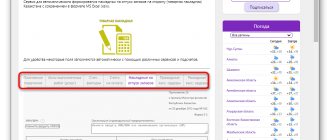Who and when is obliged to create a reserve for warranty repairs in accounting?
The company is obliged to recognize in its accounting a reserve for warranty repairs (WRR) if 3 conditions coincide at once (clause 5 of PBU 8/2010 “Estimated liabilities, contingent liabilities and contingent assets”, approved by order of the Ministry of Finance of Russia dated December 13, 2010 No. 167n):
- the company has the obligation to eliminate defects of the goods (products, works) discovered in the future during the warranty period, since it has issued a guarantee for them;
- there is a possibility of a decrease in economic benefits as a result of the fulfillment of warranty obligations;
- the amount of the provision can be reasonably determined.
The procedure for recognizing RGR in accounting:
- the liability is recognized at the reporting date;
- the amount of the RGR should allow you to pay off creditors or transfer the obligation to another person (clause 15 of PBU 8/2010);
- the estimated amount of costs for warranty repairs is assessed using actual data, based on practical experience or expert opinion (clause 16 of PBU 8/2010);
- significant amounts of RGR are disclosed in the accounting reports (clause 24 of PBU 8/2010).
The following materials will tell you about other types of estimated liabilities:
- “Provisions for doubtful debts in accounting”;
- “Reflection of the reserve for vacation pay in accounting”.
Is it necessary to form a reserve for warranty repairs and warranty service for income tax purposes, the Ministry of Finance clarified. Get free trial access to the ConsultantPlus system and find out the opinion of officials.
Amount of estimated liability
The legislation does not provide for a specific methodology for determining the amount of the estimated liability. At the same time, section III of PBU 8/2010 contains the general procedure for determining the amount of the estimated liability.
According to this procedure, an estimated liability is recognized in accounting as of the reporting date in the amount necessary to pay off creditors or transfer the liability to another person (clause 15 of PBU 8/2010). That is, the organization must estimate the expected amount of expenses that it will have to incur to fulfill warranty repair obligations. Such an assessment is made on the basis of existing facts of the organization’s economic activities, experience in relation to similar obligations of the organization or expert opinions (clause 16 of PBU 8/2010).
If the estimated liability is significant, information about it must be disclosed in the financial statements (clause 24 of PBU 8/2010).
The method by which the amount of the estimated liability is determined must be fixed in the accounting policy of the organization for accounting purposes (clause 7 of PBU 1/2008). For example, an organization has the right to estimate upcoming costs for warranty repairs taking into account available data on the actual level of costs for warranty repairs over the past year or through an expert assessment.
Situation: how to determine the date of sale of products (goods) to create a reserve for warranty repairs (warranty service), if the sale of products (goods) occurs through a commission agent?
If products (goods) are sold under a commission agreement (clause 1 of Article 990 of the Civil Code of the Russian Federation), then the date of sale is the date specified in the commission agent’s report (Article 999 of the Civil Code of the Russian Federation). With this sales option, the organization has the right to create a reserve for warranty repairs only after receiving the commission agent’s report. The date of this report will be the date the reserve was created.
Provision for warranty repairs and VAT
It is important for the company forming the RGR to remember that the following are not subject to VAT (subclause 13, clause 2, article 149 of the Tax Code of the Russian Federation):
- repair and maintenance services for goods during the warranty period of their operation, if they are provided without additional payment;
- cost of spare parts used during warranty repairs.
Explanation of the provisions of Art. 149 of the Tax Code of the Russian Federation, see the material “Art. 149 of the Tax Code of the Russian Federation: questions and answers.”
However, not everyone can take advantage of this VAT exemption.
For example, the issue of application of this exemption by third parties involved in relations with manufacturers of goods and repair companies, but not directly performing warranty repairs (the “manufacturer-distributor-dealer” chain), remains unregulated by law.
Examples of contradictory judicial positions are presented below:
- the distributor is not entitled to VAT exemption (Resolution of the 9th AAS dated October 26, 2011 No. 09AP-26094/11);
- whether the distributor has the opportunity to use the right to exemption from VAT (Resolution of the Federal Antimonopoly Service of the Moscow Region dated 02.02.2012 No. F05-13111/11).
The use of VAT exemption by dealers is interpreted clearly in their favor (letter of the Ministry of Finance of Russia dated February 28, 2013 No. 03-07-07/5908).
Another controversial situation with VAT arises if a warranty is issued by the manufacturer, but the trading company carries out warranty repairs at its own expense. In this case, the trading company must pay VAT from its own funds, since in the absence of compensation from the manufacturer, such repairs are not considered warranty and are recognized as a free service.
When and how trading companies are formed in the accounting of RGR, we will tell you in the next section.
Warranty repair costs
The list of costs associated with warranty repairs is not defined by law. Depending on how the organization carries out warranty repairs (in-house or with the assistance of service centers) and on what types of work need to be performed during repairs, the costs of warranty repairs may include:
- costs of eliminating product defects (expenses for remuneration of employees who are engaged in repairs; purchase of components (spare parts) used to eliminate defects);
- costs of delivering goods from the buyer to the seller (manufacturer) for repairs;
- costs of delivering goods from the seller (manufacturer) to the buyer after repair;
- costs of conducting an examination of goods, identifying the causes of product defects (costs of remuneration of employees who conduct the examination);
- costs of paying for repair services to a third party.
Industry specifics of the reserve for warranty repairs
The need to create a RGR may arise from different enterprises and organizations. Do industry specifics affect the algorithms for generating RGR?
To answer this question, we will focus on the scheme for the formation of RGR in 2 non-related industries: trade and construction.
RGR in trade
The need for the creation of RGR by trading companies is associated with the provision of guarantees to buyers for the goods sold. The most common type of warranty support that is beneficial for buyers is when selling household appliances.
Warranty repair costs in such a situation may only arise from one of the following entities:
- manufacturer of household appliances;
- trading company.
A trading company does not have the right to create a RGR if repairs under warranty are carried out:
- manufacturer;
- workshop of a trading company - if the manufacturer compensates for the costs incurred.
If a trading company provides customers with a company guarantee and repairs sold goods during the warranty period, it forms a RGR.
The purpose of creating a RGR in accounting is to uniformly include upcoming expenses for warranty repairs and warranty service in the costs of the reporting period of a trading company.
Regulatory grounds for the formation of the RGR:
- PBU 8/2010 “Estimated liabilities, contingent liabilities and contingent assets” (approved by order of the Ministry of Finance of Russia dated December 13, 2010 No. 167n);
- clause 72 of the Regulations on accounting and financial reporting (approved by order of the Ministry of Finance of Russia dated July 29, 1998 No. 34n).
If a trading company creates a RGR for the first time, it needs to:
- enter into the working chart of accounts. 96 “Reserves for future expenses” (if this account was not previously provided) and supplement the accounting policy with a methodology for calculating the reserve;
- the amendments made to the accounting policy should be approved by order of the manager and the involved accounting specialists should be familiarized with them;
When developing a methodology for calculating RGR, a trading company can use statistical data (on breakdowns of specific goods, costs of repairing them, etc.), as well as the “tax” scheme for the formation of RGR (Article 267 of the Tax Code of the Russian Federation). The calculated annual amount of the planned RGR is approved by order of the head of the trading company before the start of the reporting year.
Example
Trading sells food processors and provides them with a 12-month company warranty (the manufacturer does not provide warranty repairs). The company’s accounting policy stipulates that the RGR is formed according to the “tax” method using data for the previous 3 years when calculating the amount of the reserve.
To form the RGR, the following data were used (for the previous 2 years):
- TC Vita's revenue for sold food processors is RUB 6,230,000. (excluding VAT);
- expenses for warranty repairs - 180,000 rubles.
Algorithm for calculating RGR:
- determination of the percentage of deductions to the Russian State Register: (180,000 / 6,230,000) × 100 = 2.889%;
- monthly deductions are made to the RGR, calculated on the basis of revenue from the sale of food processors and the percentage of deductions. For example, with revenue in January of 112,000 rubles. this is 3,235.68 rubles. (RUB 112,000 × 2.889%).
How to take into account the costs of warranty repairs, read in ConsultantPlus. To do everything correctly, get trial access to the system and go to the Typical Situation. It's free.
RGR in construction
Construction companies, like trading companies, have to deal with warranty obligations - if the construction contract stipulates that the contractor, during the warranty period, is obliged to eliminate at his own expense defects that were not identified during the acceptance of the work performed.
For uniform recognition in accounting of expenses associated with the performance of these duties, the construction company creates a RGR.
However, a construction company has the opportunity not to fulfill warranty obligations if the shortcomings and defects that arise are not due to its fault, but in connection with (clause 2 of Article 755 of the Civil Code of the Russian Federation):
- normal wear and tear of the object (or its parts);
- improper use;
- incorrect application of operating instructions developed by the customer or third parties involved;
- improper maintenance and (or) repairs performed by the customer (general contractor or involved subcontractors).
It is necessary to take into account that paragraphs. 2 and 4 tbsp. 724 of the Civil Code of the Russian Federation stipulate that the customer (general contractor) has the right to demand that the contractor eliminate deficiencies within 5 years from the moment the result of the work was accepted - the possibility of reducing this period is not provided for by law.
Thus, construction companies - unlike trade companies - have a legally established minimum period during which they are obliged to carry out warranty repairs and, in connection with this, may incur corresponding costs.
Otherwise, the approaches to the algorithms for generating RGR for a construction company are similar to those described above for trading companies.
Creation and use of a reserve for warranty repairs
Due to the specifics of its activities, the contracting construction organization must be ready at any time to eliminate, at its own expense, shortcomings in the results of previously completed construction and installation works
Moreover, the warranty period is often set in the contract for several years. Thus, even after the delivery of the object to the customer, the contractor still has obligations under the contract for a long period. Their implementation in the future may entail significant material costs. To mitigate possible negative consequences and save on income tax, contractors create a reserve for warranty repairs. Creating a reserve In tax accounting, creating a reserve for all taxpayers is a right, that is, the organization independently decides to form a reserve for warranty repairs and maintenance ( clause 1 of Article 267 of the Tax Code of the Russian Federation ). This decision must be enshrined in the contractor's tax accounting policy. In accounting, for some contractors, creating such a reserve is not a right, but an obligation. Judge for yourself. According to clause 3 of PBU 8/01 “Conditional facts of economic activity”, warranty obligations issued by the organization in relation to products, goods sold by it in the reporting period, work performed, services rendered are recognized as conditional facts of economic activity. In other words, by issuing a guarantee for the results of work performed to the customer during the reporting period, the contractor assumes the responsibility to eliminate deficiencies identified during the warranty period. That is, the contractor has the possibility that in the future (during the warranty period) the economic benefits of the organization will be reduced by the amount of costs to eliminate defects. If it becomes possible to reduce economic benefits in the future, this fact should be reflected in the financial statements in the amount of expected expenses. Otherwise, users of the statements will be misinformed about the organization’s possible losses, which means that users and auditors have the right to talk about the possible unreliability of the financial statements. The likelihood of the contractor incurring costs for warranty repairs and maintenance is conditional. It is quite possible that all the work was done efficiently and the customer will not make any claims. At the same time, the need to redo the work (part of the work) cannot be ruled out. Thus, the contractor has a contingent liability. For contingent obligations existing at the reporting date, the fulfillment of which the organization cannot refuse, the accountant is obliged to create a reserve if there is a very high or high probability that future events will lead to a decrease in the economic benefits of the company ( clause 8 of PBU 8/01 ). In this case, a very high or high probability usually indicates that the organization does not have the opportunity to refuse to fulfill the obligation either based on the requirements of the contract or current legislation, or based on the established practice of the organization. The assessment of the likelihood of the obligation to eliminate at its own expense deficiencies in the results of work delivered to customers is carried out by the organization independently, taking into account the recommendations given in the table given in the appendix to PBU 8/01.





